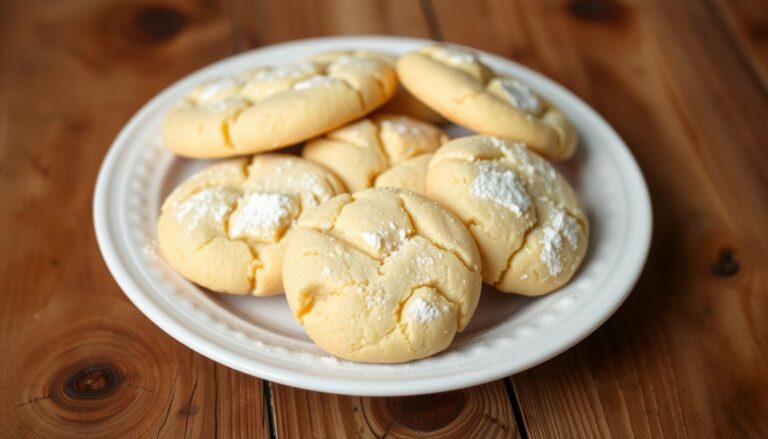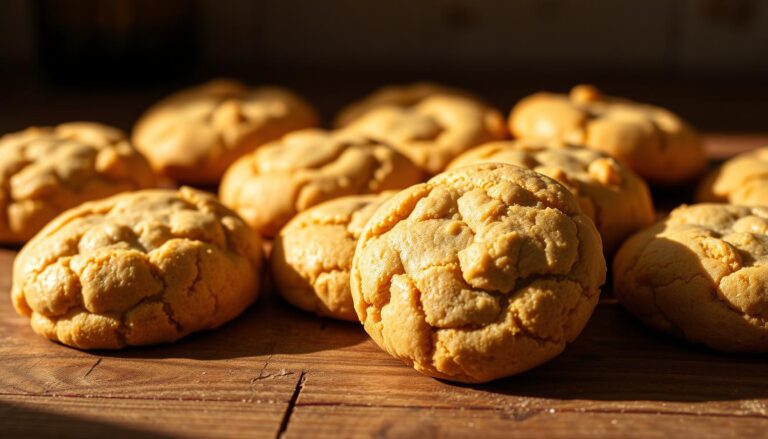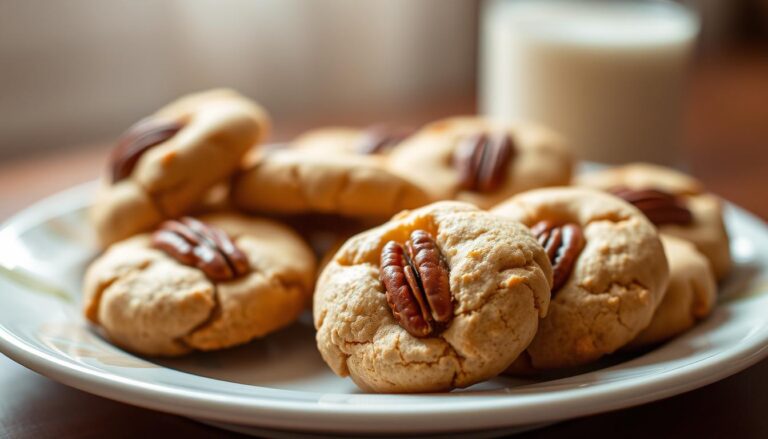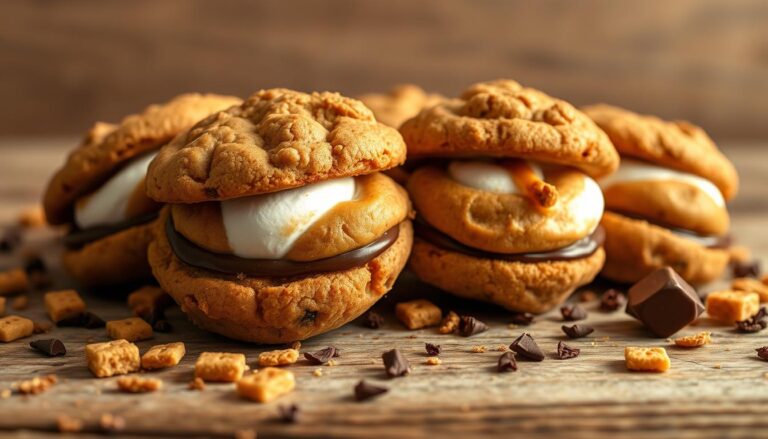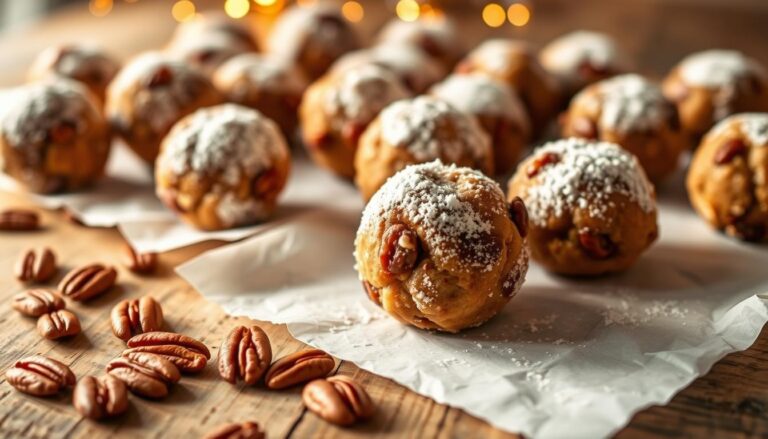Delicious Pignoli Cookies Recipe: Authentic Italian Delight
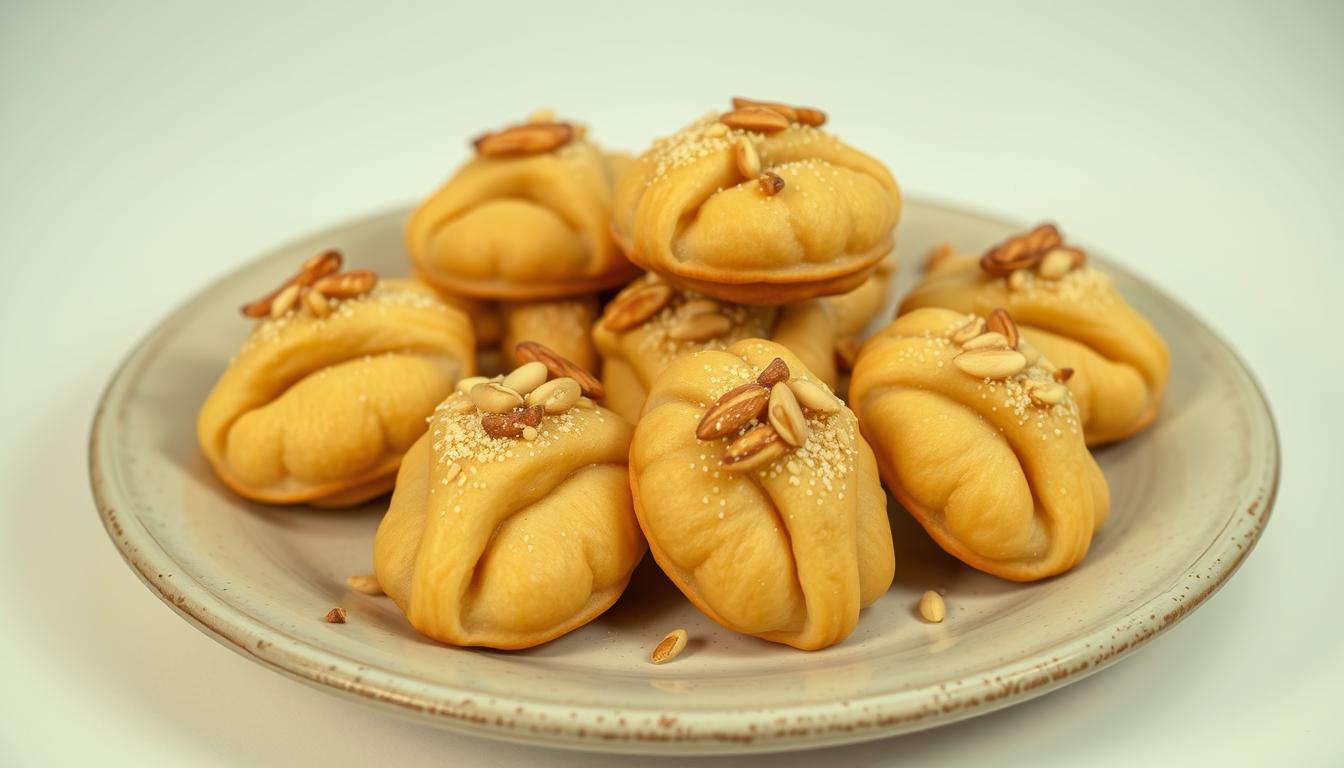
Pignoli cookies recipe : the smell of freshly baked pignoli cookies reminds me of my grandmother’s kitchen in Sicily. These golden, nutty treats with pine nuts are more than a sweet snack. They bring back memories of family, tradition, and cooking that connect us across generations.
Pignoli cookies are at the heart of Italian dessert culture. They are soft, chewy, and have a special crunch from the pine nuts. These cookies are not just a dessert but a celebration of simple, high-quality ingredients turned into magic.
If you love baking or appreciate authentic cultural food, these cookies are for you. They offer a taste of Sicily’s rich culinary heritage. Get ready to learn the secrets of making these irresistible treats.
Table of Contents
Key Takeaways
- Pignoli cookies originate from traditional Sicilian baking
- Pine nuts are the signature ingredient in these cookies
- These cookies represent more than just a dessert – they’re a cultural experience
- Authentic recipes require minimal ingredients with maximum flavor
- Baking pignoli cookies connects you to Italian culinary traditions
The History and Origins of Traditional Italian Pignoli Cookies
Authentic pignoli cookies are more than a sweet treat. They show Sicily’s rich food history, passed down through generations. They are a key part of family recipes and traditions.
The tale of pignoli cookies starts in southern Italy’s sunny lands. Here, almonds and pine nuts grow in abundance. These cookies come from a tradition that values simple, quality ingredients and old cooking ways.
Sicilian Culinary Roots
Sicilian kitchens are famous for making amazing dishes from basic ingredients. Pignoli cookies show this skill. They mix:
- Locally harvested pine nuts
- Almond paste from local almonds
- Little sugar to keep natural tastes
Cultural Celebrations and Significance
In Italian families, pignoli cookies mean more than dessert. They stand for:
- Family get-togethers
- Holiday celebrations
- Keeping family recipes alive
These cookies are a big part of Christmas, weddings, and religious events. They bring families together through food.
Essential Ingredients for Perfect Pignoli Cookies
Making the best pignoli cookies needs the right ingredients. Knowing each part is key to getting that true Italian taste.

Pignoli cookies are special because of their simple ingredients. Success comes from using top-notch parts that blend well together.
Understanding Almond Paste Quality
Almond paste is the base of your cookies. Choose brands that:
- Are made from pure ground almonds
- Have little added sugar
- Are smooth and even
“The quality of almond paste can make or break your pignoli cookies” – Italian Pastry Experts
Selecting the Best Pine Nuts
Pine nuts, or pignoli, are more than just a topping. They’re a key flavor in your cookies.
| Pine Nut Type | Origin | Flavor Profile |
|---|---|---|
| Mediterranean | Italy, Spain | Rich, buttery, intense |
| Chinese | China | Milder, less expensive |
Additional Key Components
Along with almond paste and pine nuts, you’ll need:
- Egg whites (for binding)
- Powdered sugar
- Vanilla extract (optional)
- Almond extract (for extra flavor)
Pignoli Cookies Recipe: Step-by-Step Instructions
Making the perfect pignoli cookies recipe needs precision and care. This easy pignoli cookies recipe will help you make these delightful Italian treats in your kitchen.
Before starting, collect these key ingredients for your pignoli cookies recipe:
- Almond paste
- Granulated sugar
- Salt
- Almond extract
- Egg whites
- Pine nuts
Follow these easy steps for a pignoli cookies recipe that will wow your family and friends:
- Preheat your oven to 325°F
- Prepare baking sheets with parchment paper
- Crumble almond paste in a medium bowl
- Mix in sugar, salt, and almond extract
- Add egg whites and beat until smooth
- Form 1-inch dough balls
- Carefully roll balls in pine nuts
- Place cookies 1 inch apart on baking sheets
- Bake for 22-24 minutes until lightly browned
- Cool on pans for 5 minutes
- Transfer to cooling rack
Pro tip: Make sure your dough is thick and tacky. If it’s too dry, add a bit of water. The secret to authentic pignoli cookies is in the right mix of ingredients and careful prep.
Mastering this pignoli cookies recipe takes practice, but the delicious results are well worth the effort!
Tips for Working with Sticky Cookie Dough
Making homemade pignoli cookies can be tough because of the sticky dough. Learning the right techniques can make your baking easier and your cookies perfect every time.
Sticky dough doesn’t have to ruin your cookie-making. With the right steps, you can handle even the stickiest pignoli cookie mix.
Proper Handling Techniques
When dealing with sticky pignoli cookie dough, preparation is crucial. Here are some key tips:
- Keep a small bowl of water nearby to wet your hands
- Chill the dough for 30-45 minutes before shaping
- Use gentle, light touches when handling the mixture
- Dust your work surface lightly with powdered sugar instead of flour
Essential Tools for Success
Choosing the right tools can make making homemade pignoli cookies easier:
- Cookie Scoop: A medium-sized (1.5 tablespoon) scoop ensures uniform cookie sizes
- Parchment Paper: Prevents sticking and provides a smooth rolling surface
- Silicone Baking Mat: Offers non-stick, reusable solution for baking
- Chilled Baking Sheet: Helps keep dough temperature steady during shaping
By using these techniques, you’ll become a pro at making delicious pignoli cookies with less hassle.
Baking Techniques for the Perfect Texture
Making the best pignoli cookies recipe needs you to learn special baking techniques. These techniques turn simple ingredients into a tasty Italian treat. The key to getting that perfect pignoli cookies texture is knowing the right baking methods.
Here are some important baking tips for your pignoli cookies:
- Preheat your oven to 350°F for the best results
- Use a light-colored baking sheet to avoid too much browning
- Place cookies evenly to bake them all the same
- Keep an eye on cookies in the last few minutes of baking
The perfect baking time is between 15-17 minutes. Your classic pignoli cookies are done when they’re lightly golden and still a bit soft in the middle. The pine nuts should also be a pale golden-brown, adding a nice look and feel.
Cooling is key for the perfect texture. Let the cookies cool on the baking sheet for 5 minutes after baking. This helps them firm up without getting too hard. Then, move them to a wire rack to cool completely. This keeps their soft and chewy inside just right.
Pro tip: Every oven is different, so start checking your cookies a few minutes early to avoid overbaking.
Remember, practice makes perfect with the best pignoli cookies recipe. Each batch will help you get to know your oven better and improve your baking skills.
Common Mistakes to Avoid When Making Pignoli Cookies
Learning to make pignoli cookies needs focus and knowing common mistakes. These Italian treats can turn out wrong if you don’t follow the right steps.
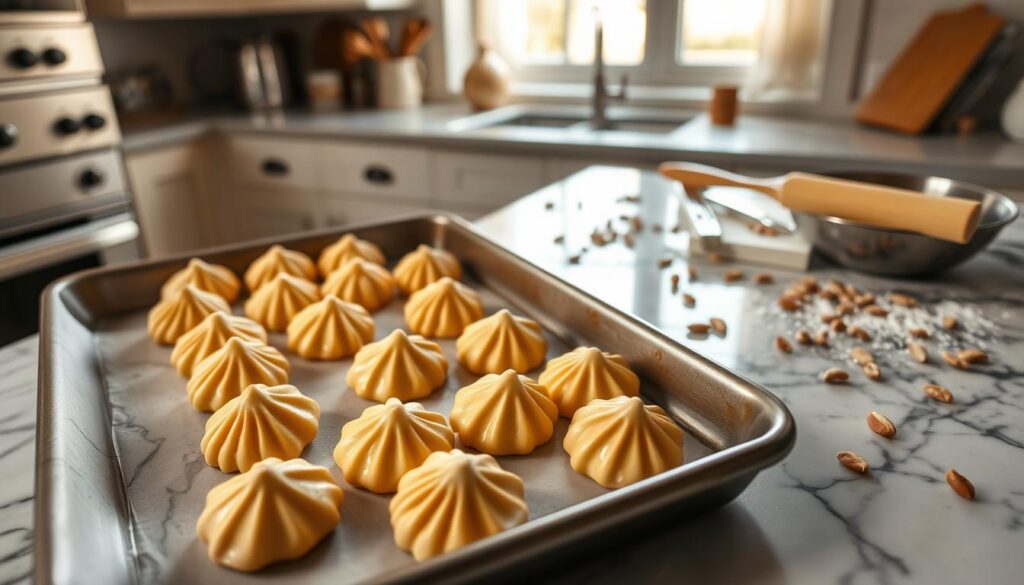
To bake these delicate treats, you must be precise and use the right techniques. Knowing what mistakes to avoid can help you make perfect cookies every time.
Temperature and Baking Challenges
The oven’s temperature is key for making authentic pignoli cookies. Keep an eye on the baking time to avoid overcooking. For convection ovens, lower the temperature by 25 degrees and check for doneness sooner.
- Check cookies at the 15-minute mark
- Look for light golden brown edges
- Ensure centers remain slightly soft
Ingredient Measurement Precision
Getting the ingredient measurements right is essential for pignoli cookies. Use canned almond paste instead of the tube kind, which can be too crumbly. The dough should be thick and sticky.
- Use a food processor to mix almond paste
- Add egg whites slowly
- Aim for sticky but shapeable dough
Storage and Handling Tips
Storing your cookies properly keeps them fresh. Use parchment paper for baking and storing to prevent sticking. Let cookies cool completely before taking them off the baking sheet.
- Store in airtight containers
- Layer with wax paper
- Keep at room temperature for up to 1 week
- Freeze for up to 6 months if needed
Pro tip: Keep a bowl of water nearby when shaping cookies to manage the sticky dough. A cookie scoop can also help create uniform sizes and reduce mess.
Storage and Shelf Life Guidelines
Keeping traditional pignoli cookies fresh is key. They can stay delicious for a while if you store them right. Here are some tips to keep your homemade pignoli cookies tasty.
For a short time, store them in an airtight container at room temperature. They’ll stay fresh for 5 to 7 days. Make sure to seal them well to keep air out.
- Room temperature storage: Up to 5-7 days
- Use a tight-sealing container
- Keep away from direct sunlight
Freezing extends the life of your homemade pignoli cookies. To freeze them, follow these steps:
- Allow cookies to cool completely
- Layer with parchment paper between cookies
- Place in a freezer-safe container
- Freeze for up to six months
When you want to eat your frozen cookies, thaw them slowly. Take them out of the freezer and let them sit at room temperature for an hour. For a warm treat, warm them in a 250°F oven for a few minutes.
Pro tip: Always store traditional pignoli cookies in a cool, dry place to preserve their unique texture and rich almond flavor.
Nutritional Information and Dietary Considerations
Authentic pignoli cookies are more than a tasty treat. They have a nutritional profile that might surprise you. Knowing what’s in these Italian pignoli cookies helps you enjoy them as part of a healthy diet.
| Nutrient | Amount per Cookie |
|---|---|
| Calories | 121 kcal |
| Carbohydrates | 13g |
| Protein | 2g |
| Total Fat | 7.4g |
| Sugar | 11.2g |
Dietary Considerations for Pignoli Cookie Lovers
Enjoying authentic pignoli cookies might depend on your diet. Here are some key points:
- Nut Allergies: Contains pine nuts and almond paste – not good for nut allergy sufferers
- Gluten Sensitivity: Traditional recipes often include wheat flour
- Vegetarian Friendly: Most pignoli cookie recipes are vegetarian
Dietary Adaptations
If you have dietary restrictions, you can make pignoli cookies work for you by:
- Switching to gluten-free flour
- Replacing almond paste with something nut-free
- Lowering sugar for those on low-sugar diets
While these Italian pignoli cookies are delicious, they should be part of a balanced diet. Enjoy them in moderation.
Conclusion
Making classic pignoli cookies is more than just a recipe. It’s about diving into Italian culinary tradition. Now, you can make these tasty treats at home. You’ll connect with Italian baking history through simple ingredients.
The beauty of these cookies is their simplicity and rich taste. Learning the right techniques, like choosing quality pine nuts and baking them just right, will boost your baking skills. You’ll impress everyone with your traditional Italian cookies.
Your journey with pignoli cookies is just starting. Each batch you make will help you get better. Enjoy them on special occasions or with a cup of espresso. These cookies bring a taste of Italy into your home.
We encourage you to share your pignoli cookie stories and try new things. Start your Italian baking adventure with these cookies. It’s a great way to explore traditional Italian desserts.
FAQ
What are pignoli cookies?
Are pignoli cookies difficult to make at home?
What ingredients do I need to make authentic pignoli cookies?
How long do pignoli cookies stay fresh?
Are pignoli cookies gluten-free?
Can I make pignoli cookies if I’m allergic to nuts?
What’s the difference between almond paste and marzipan?
How do I prevent my pignoli cookies from sticking to the baking sheet?
What is the nutritional profile of pignoli cookies?
Can I modify the recipe for dietary restrictions?
Leave a review :
There are no reviews yet. Be the first one to write one.

